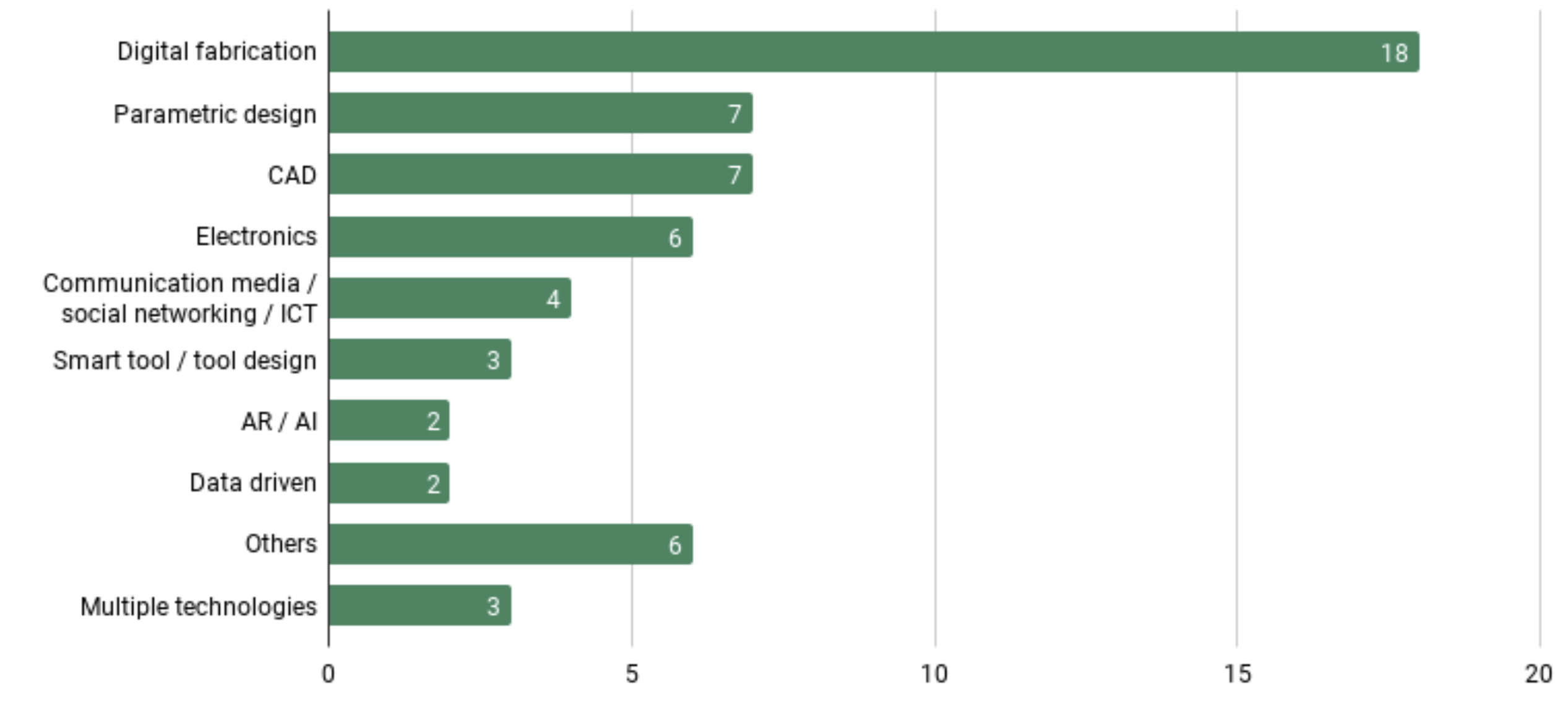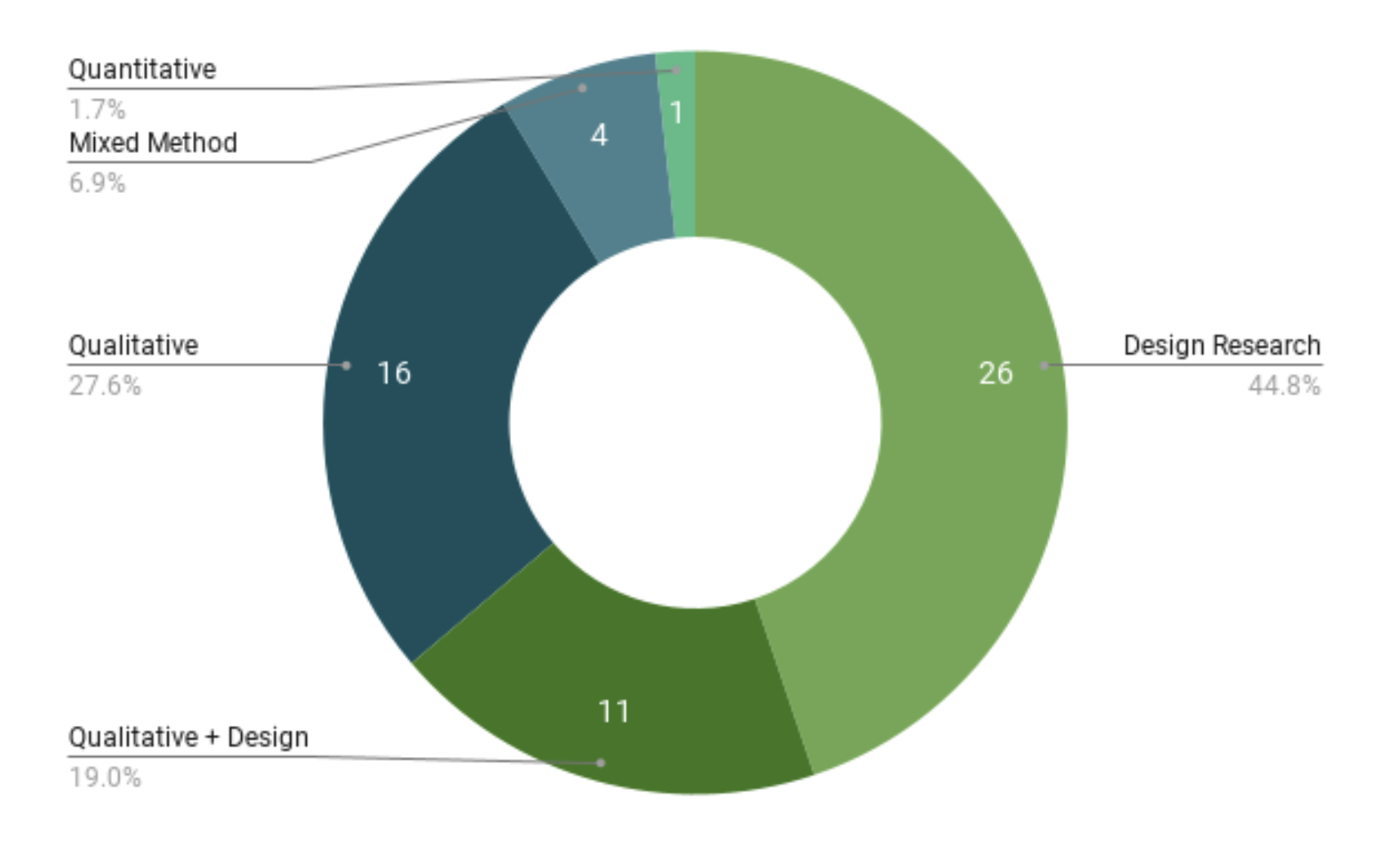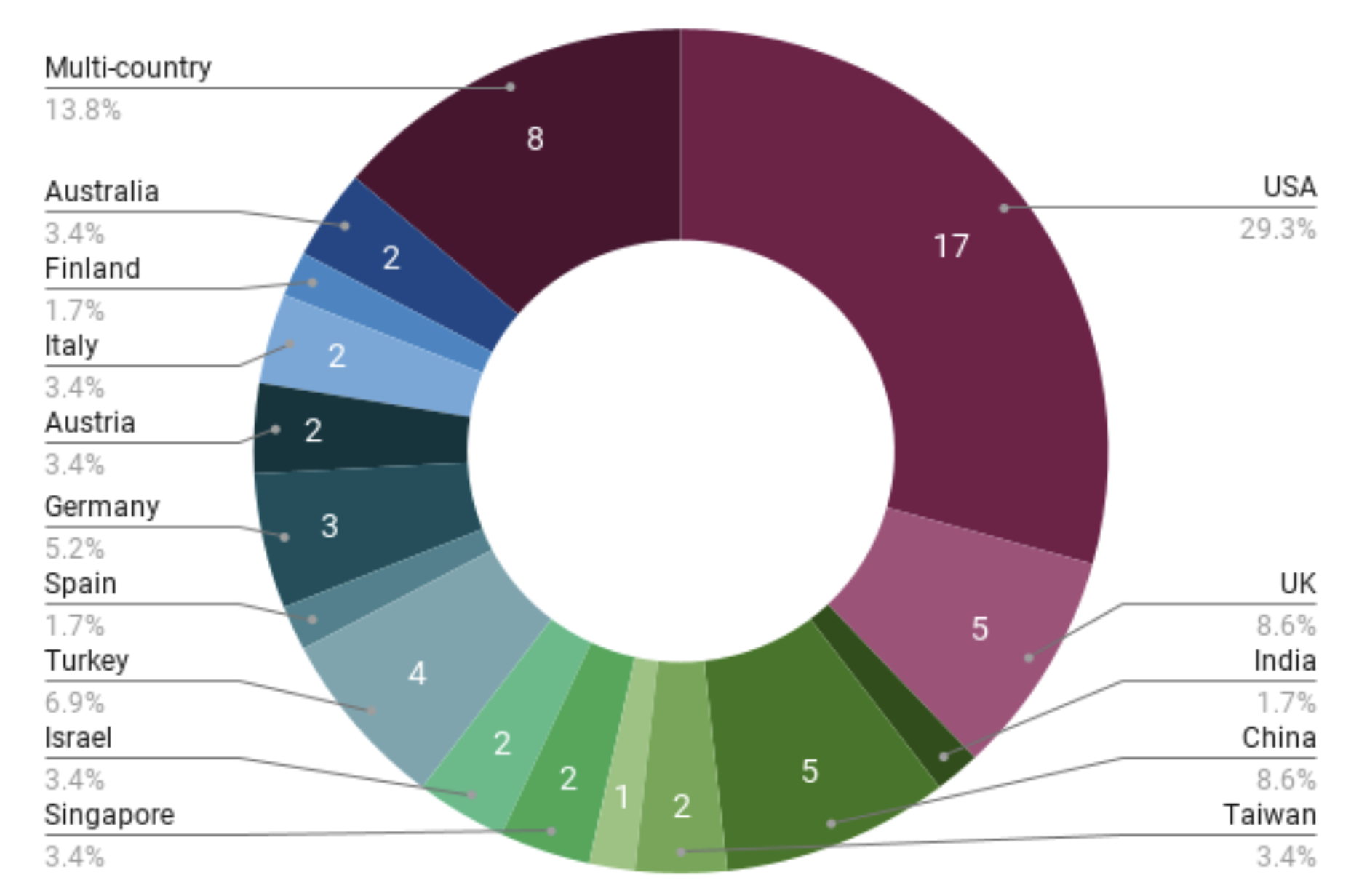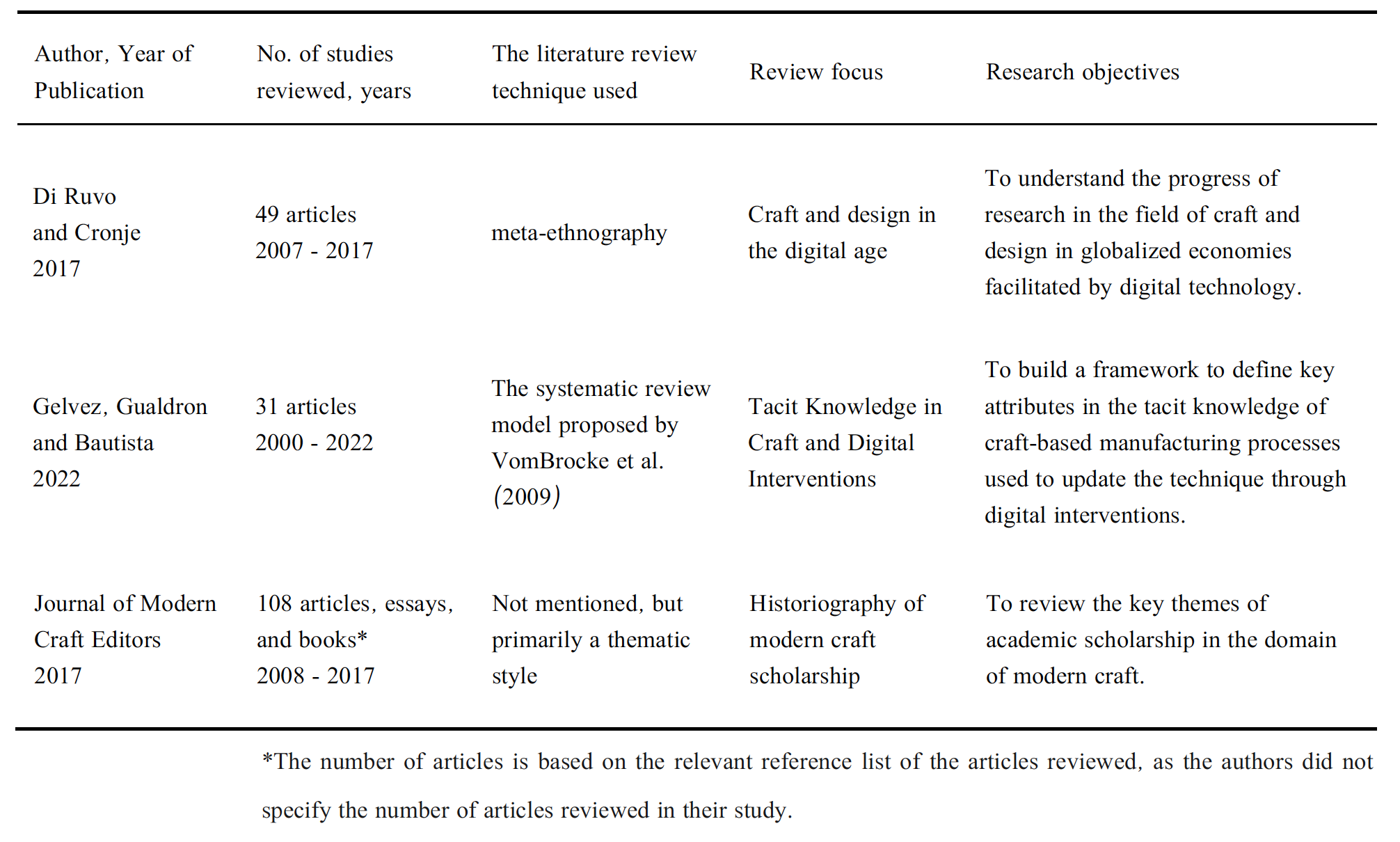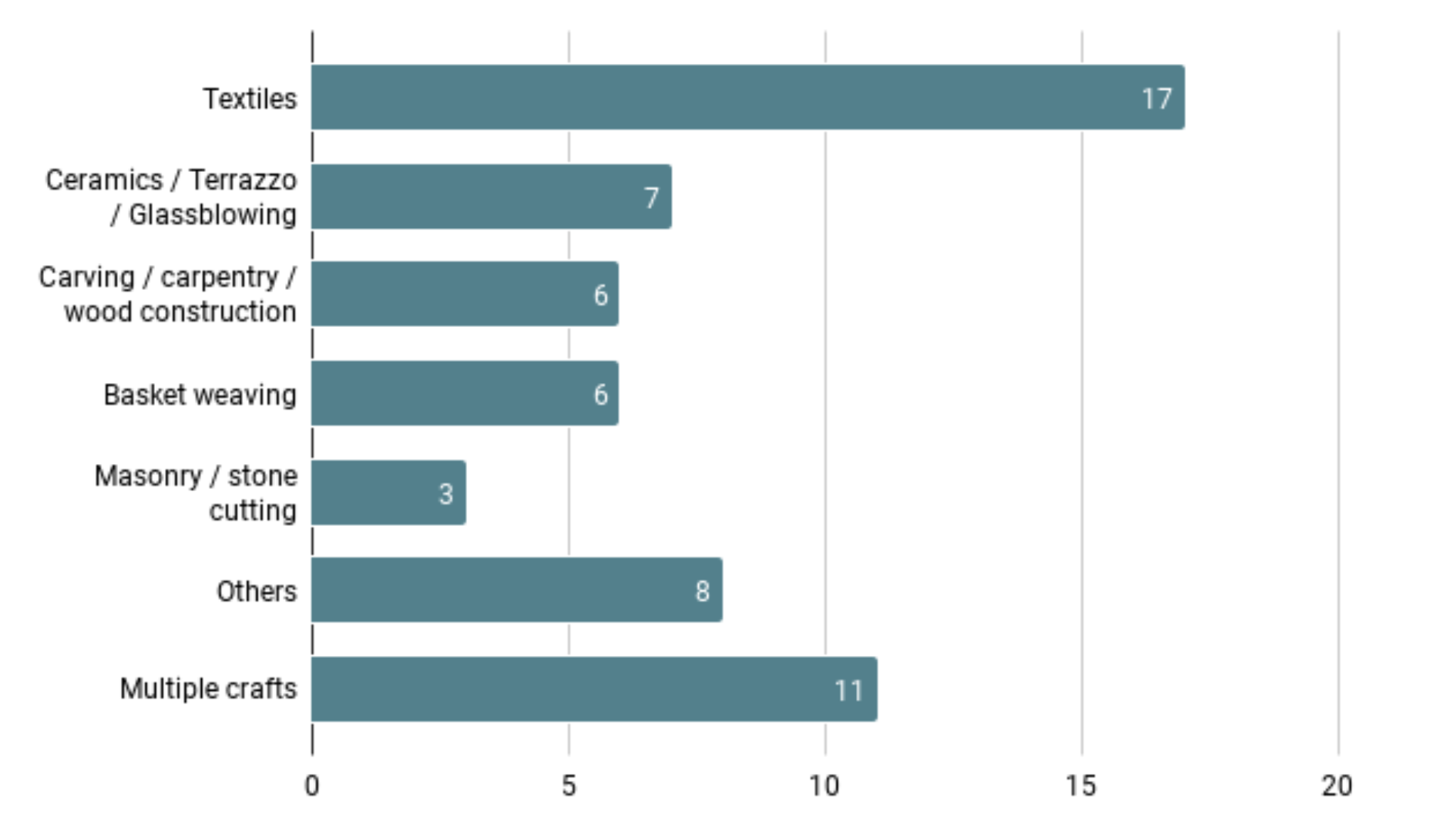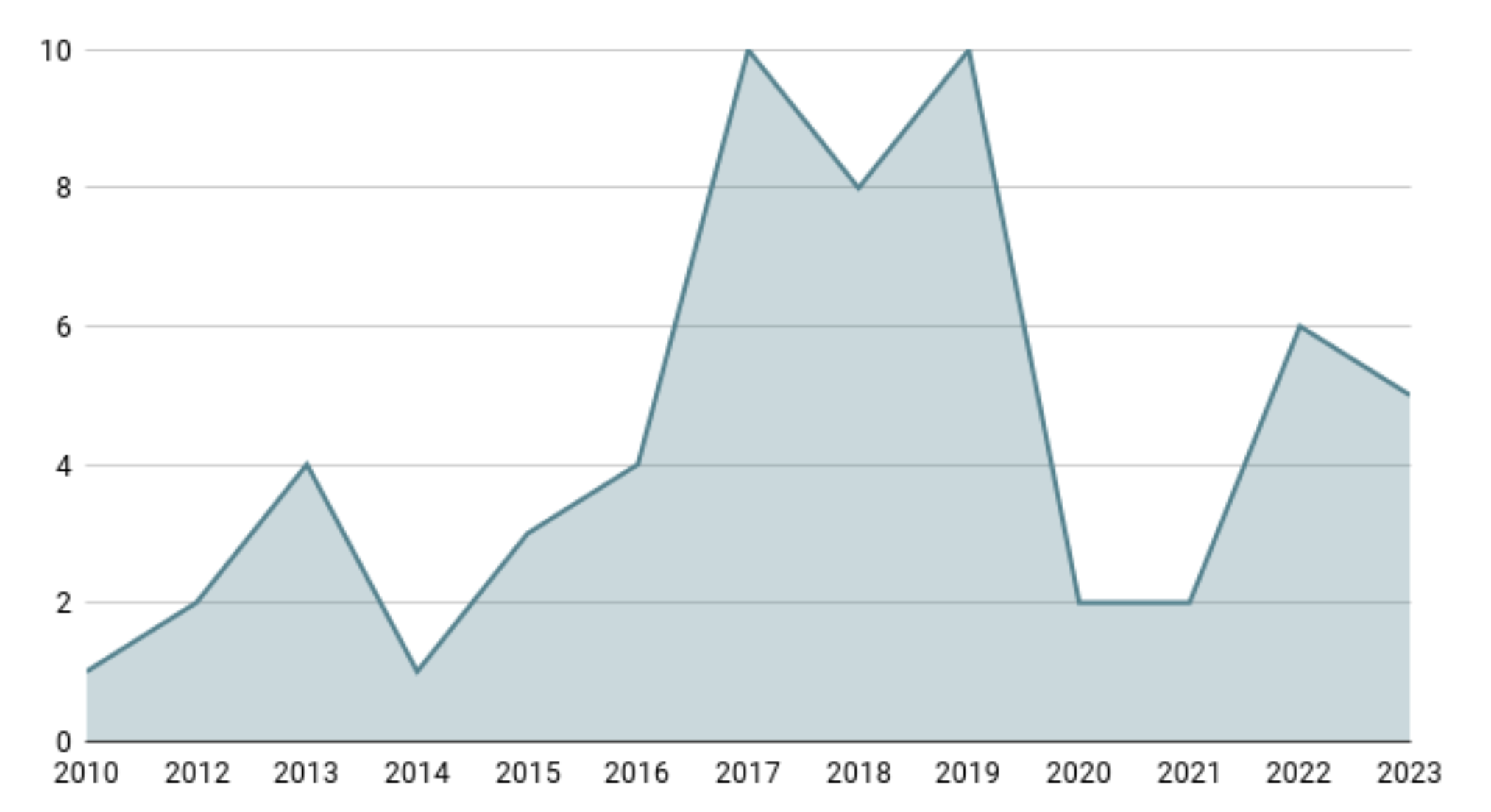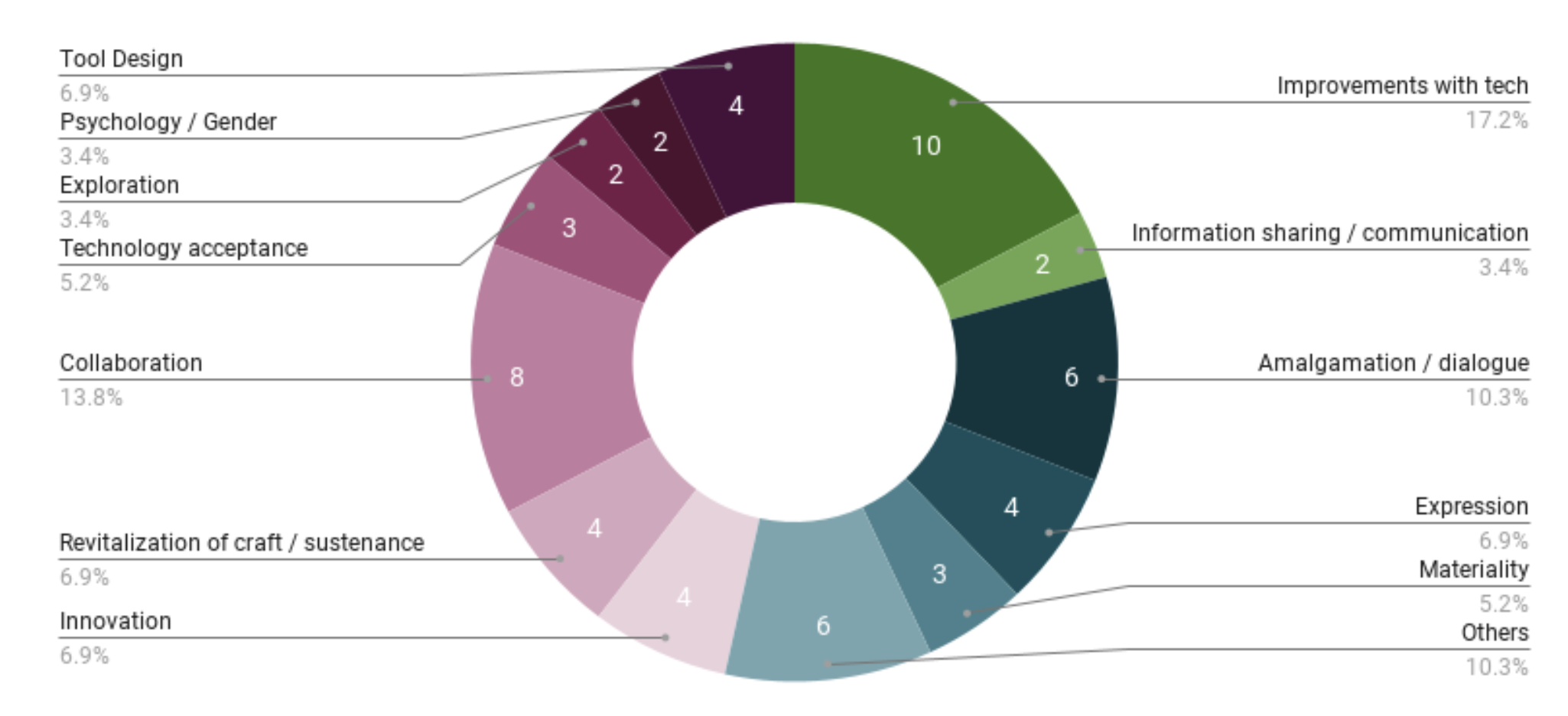The second most focused construct was collaboration. Although 48 of the 58 articles exhibited collaboration of some form, only eight articles addressed collaboration as a construct. Four of these studies focused on using collaboration to enhance knowledge sharing among the participants. Other studies highlighted collaborations aimed at increasing engagement and social play [43], promoting the concepts of open source and co-design [44], and creating a bridge for non-digital communities to participate in the dialogue surrounding technological advancements [45]. The third most explored construct was the amalgamation of craft and technology, fostering a dialogue between craftspeople and the growing number of design venues dedicated to digital fabrication [46].
Other constructions that were found in at least four studies included innovation, expression, revitalization, sustenance of the craft, and tool design. Innovation fostered a discussion on the potentials and challenges of technology usage within the craft sector [34]. Expression focused on the transmission of cultural values and humanness into the technological processes used during the study [47]. Revitalization as a construct addressed efforts taken by the craftspeople in collaboration with designers and technology to ensure the sustenance of a craft for the future [48]. Other constructs focused in the studies included exploration of materiality (3/58 articles), understanding the level of acceptance of the new technology amongst craftspeople (3/58 articles), psychological effects [49], personalization [13], empowerment [12], and local production [50].
2.4. Methodologies (M)
In this section, we present the methodologies used by researchers in the domain of “craft-design-technology” coalescence. Notably, the maximum number of articles used was design research (26/ 58 articles), followed by 16 articles that employed qualitative methods (Figure 6).
When Craft, Design, and Technology Coalesce: Mapping Global Research Trends and Future Directions for India
With this systematic literature review (SLR), this study aims to answer the following questions:
- What are the various theories (T), contexts (C), characteristics (C), and methodologies (M) used in the existing literature on the coalescence of craft, design, and technology?
- What are the future research agendas under each element of the TCCM framework that could be applied to the Indian context of craft, design, and technology coalescence?
The uniqueness of this study lies in the comprehensive examination and synthesis of articles in this domain, analyzed through each aspect of the TCCM framework. This approach can serve as a roadmap for designers and design researchers to develop future work that integrates craft and technology. Paul et al. described the Scientific Procedures and Rationales for Systematic Literature Review (SPAR-4-SLR), which was utilized for conducting a systematic review [6]. SPAR-4-SLR is a three-phase procedure that involves assembling, arranging, and assessing the literature on the coalescence of “craft-design-technology.”
1.1. Assembling
Research articles were gathered from Scopus and Web of Science databases. To ensure the inclusion of all relevant articles in the intersection of craft, design, and technology, the keywords were selected as seen in Table 2:
Table of Contents
- Abstract
- Introduction
- Systematic Literature Review Using the TCCM Framework
- Future Research Directions for the Indian Context
- Conclusion
- Author Contributions
- Funding
- Acknowledgements
- Conflicts of Interest
- Author Biographies
- References
1. Introduction
A key milestone in the evolution of the design discipline of India is the Ahmedabad Declaration, which was signed during “the Meeting for the Promotion of Industrial Design in Developing Countries,” convened by the United Nations Industrial Development Organization (UNIDO) in close collaboration with the International Council of Societies of Industrial Design (ICSID) and the Indian National Institute of Design in January 1979 [1]. Balaram recounts that the Ahmedabad Declaration recognized that “through design, relevant cultural traditions can be preserved and utilized to current advantage.” It also asserted that “design in the developing world must be committed to a search for local answers to local needs, utilizing indigenous skills, materials, and traditions while absorbing the extraordinary power that science and technology can make available to it.”
Indigenous skills, materials, and traditions all relate to the one common term of “craft.” Designing for the Indian market by integrating craft and technology requires careful consideration, as the work k styles of craft and technology are distinct. David Pye describes craftsmanship as “workmanship of risk,” where the final output cannot be preconceived as it depends on the “judgment,” “dexterity,” and “care” of the craftsperson. He contrasts this with the “workmanship of certainty,” where technology can be employed to give the exact preconceived output and possible replication in mass quantities [2].
Thus, our research lies at the intersection of the three disciplines of craft, design, and technology. This domain has been a persistent subject of research over the past three decades, with its significance growing over time, as evidenced by the increasing number of articles, scholarly studies, and recent special issues in reputable craft and design journals such as the Journal of Modern Craft, Leonardo, Craft Research, and The Design Journal, among others.
To gain a comprehensive understanding of the “craft-design-technology” coalescence, we look at recent studies across the world in detail. While literature review articles in this domain have been identified, they exhibit certain limitations. As seen in Table 1, some reviews have not included the most recent studies from the past five years [3], which are necessary to understand the impacts of dynamic technology advancements. Also, other reviews tend to focus narrowly on specific areas within this domain, such as tacit knowledge [4]. Additionally, none of the existing review articles systematically encompass all the elements outlined in the framework developed by Paul and Rosado-Serrano, which provided a detailed understanding of the theories, contexts, characteristics, and methodologies (TCCM) relevant to the articles chosen for review [5]. This is necessary to identify the gaps in each area and examine the relevance of such research in the Indian context.
4. Conclusion
We conducted a Systematic Literature Review using the TCCM framework for the domain of “craft-design-technology” coalescence. Through this, we identified the patterns followed by researchers worldwide and proposed future research directions in the context of India. This was necessary as the analysis of the SLR article set revealed a stark underrepresentation of research from India, despite its rich craft heritage.
The findings revealed distinct approaches followed by the researchers in Western and Asian contexts. We see that Western studies focus on using technology to improve the efficiency of craft practices, while Asian studies focus on cultural preservation. This is often due to the Western studies focusing on hobbyist crafts, while the Asian studies work with indigenous crafts. While both approaches offer valuable insights, we propose that research in India should find the right balance between both, with adequate care given to the collaboration methods in order to ensure equitable representation of the designers and the craftspeople. India’s craft heritage presents a complex ecosystem with diverse material culture perspectives that vary largely amongst different crafts. This, coupled with the low penetration of technology amongst the craftspeople, presents a unique set of challenges that may arise when designers collaborate craftspeople—a concern further explored in a recent practical study by the authors [60]. Thus, future research in this domain should facilitate the cross-transfer of knowledge rather than reinforce hierarchical relationships. A balanced approach that honors craft heritage while exploring the potential of technological augmentation could help to realize the vision articulated in the Ahmedabad Declaration.
Although all the articles include some elements of craft, design, and technology, a prominent correlation between any two of them can be seen in almost every article. After a comprehensive analysis of the article set, the articles can be grouped into four categories based on the elements of craft, design, or technology that can be observed prominently in the domain. In the first category of articles, technology is used to produce a desirable effect on existing practices of craft (30/58 articles). In the second category, the values of a particular craft have been transferred to alter technological processes (6/58 articles). The third category employs design interventions to affect craft practices (7/58 articles). Lastly, the fourth category employs a hybridization of craft and technological concepts to influence the design process (12/58 articles).
3. Future Research Directions for the Indian Context
The review and synthesis of the 58 articles provided valuable insights into research in this domain from a global perspective. Although we can deduce an overview of the Asian perspective, Indian representation was notably lacking within the article set. This shows an inadequacy in meeting the aspirations set forth by the Ahmedabad Declaration of 1979. Due to the low penetration of technology amongst the craftspeople in India, explorations of “craft-design-technology” coalescence are minimal, except for a handful of student projects. Thus, in this section, we consider a few research articles gathered organically, along with the 58 articles of the SLR, to propose future research directions appropriate for this domain in the Indian context. We lay out the possible directions within the TCCM framework, but the list is not exhaustive. Since the expanse of crafts in India is large and substantially varied, researchers are advised to judge the appropriateness of these directions based on the particular craft cluster in consideration.
2.2.1. Countries
As expected, given the origin of the Maker Movement in the USA, maximum studies in the domain of “craft-design-technology” coalescence have been conducted in the USA (17/58). Several of these studies featured hobbyist crafts such as sewing and paper craft integrated with digital fabrication technologies such as 3D printing and CNC milling. When it comes to indigenous crafts and traditions, researchers from the USA have collaborated with local researchers, designers, and craftspeople in countries such as South Africa [28], Trinidad [29], and India [30]. The UK is also a significant contributor, with five studies, including four collaborative studies with other countries like Korea [31] and Malaysia [32]. The Majority of studies from the UK have focused on textiles, especially the integration of electronics with textiles. Among other European countries, Germany (3/58), Austria (2/58), and Italy (2/58) were the major contributors, with one study each from Spain [33] and Finland [34].
This trend is less widespread in the Middle East and Asian countries. Turkey has contributed four studies, and Israel has contributed two. There are only eleven contributions from Asia, with China being the highest contributor (5/58), followed by Taiwan and Singapore with two studies each. India [35] and Indonesia [36] have contributed only one study each, reiterating the space for exploration in the domain of “craft-design-technology” coalescence. Although there is a rich heritage of craft in many of the Asian countries, low penetration of technology and slower spread of the Maker Movement amongst the craftspeople themselves could have contributed to this. Other reasons for the scarcity of such explorations could be the financial constraints associated with such interventions. In India, access to the basic fabrication technology itself is far from the reach of many craft communities. This hinders the opportunities for seamless integration of technology with craft. Notably, the Asian studies feature crafts indigenous to particular countries, and hobbyist crafts are featured only in two instances.
2.2.2. Crafts and Technologies
Having been cited 96 times, the article by Buechley and Perner-Wilson (2012) could be considered a seminal work in this domain. This maximum cited article of the article set examined the intermixing of carving, sewing, and painting with electronic technology. This served as a foundation for 17 additional studies that featured textiles combined with technology. When grouping the studies by craft (Figure 3), seven articles focused on ceramics, terrazzo, and glassblowing; six articles on carving, carpentry, and wood construction; and another six articles on basket weaving. Eleven articles, including the work of Buechley and Perner-Wilson (2012), considered multiple different crafts for each study. Another eleven articles researched handicrafts related to masonry [37], stone-cutting [38], jewelry making [39], wire-bending [40], and paper craft [41].
As expected from the global spread of FabLabs, digital fabrication technologies were explored the most (18/58 articles). Among these, 3D printing was the most extensively used, probably due to the decreasing costs of the machines (Figure 4). Parametric design and CAD (Computer-Aided-Design) Software were also integrated with craft in fourteen studies. This was followed by the use of electronics featured in six studies. Smart tools, AI (Artificial Intelligence), AR (Augmented Reality), and data-driven design were less explored in a total of seven studies, owing to the budding nature of such technologies within the past decade. Communication media, social networking, and information technology were used in four instances in the development of the craft.
2.2. Contexts (C)
The 58 studies were conducted in various countries across the world, with 8 studies featuring multinational collaborations, as seen in Figure 2. In terms of industries, a wide range of crafts and technologies have been the focus of study. The following subsections detail the contexts of the study in terms of the region or country of the study and the craft and technology used.
2.3. Characteristics (C)
The Design Journal, Leonardo, and ACM Transactions on Computer-Human Interaction, Proceedings of the Conference on Human Factors in Computing Systems were the major publishers of the research in the domain of “craft-design-technology” coalescence.
The articles were published in the following journals:
- International Journal of Technology and Design Education
- Design Journal
- Sustainability
- Journal of Modern Craft
- ACM Transactions on Computer Human Interaction
- Digital Creativity
- Architectural Design
- International Journal of Design Education
- Leonardo
- Computer Aided Design
- Craft Research
- Formakademisk
- Proceedings of the ACM on Human Computer Interaction
- International Journal of Architectural Computing
- Conference on Human Factors in Computing Systems - Proceedings
- Proceedings of the International Conference on Education and Research in Computer Aided Architectural Design in Europe
The majority of articles were published between 2017 and 2019 (28/58 articles). Below, we focus on the constructs that researchers have investigated in their studies.
2.3.1. Constructs
The researchers of the domain have considered different constructs appropriate to their studies (Figure 5). The majority of articles have addressed the construct of improving a craft with the aid of technology (10/58 articles). These studies included the enhancement of craft practice through a digital sonification system that translated practitioners’ gestures into sound, enabling post-practice reflection and consequent development [38]. Other studies focused on improving the workflow through technology, such as reducing wastage of material used as support structures [39], reducing manual labor intensiveness [22], or even creating new affordances for specific crafting methods [42].
Abstract: The Ahmedabad Declaration of 1979 marked a pivotal moment for design in India, advocating the integration of indigenous heritage with advancements in technology to address local needs. To gain a comprehensive understanding of the “craft-design-technology” nexus, it is essential to examine recent studies across the world in detail. This domain has been a persistent subject of research over the past three decades across the world, with its significance steadily growing, as evidenced by the increasing number of articles, scholarly research, and recent special issues in reputable craft and design journals. To gain key insights into the field, we conducted a Systematic Literature Review (SLR) using the TCCM framework, which facilitated the analysis of Theories (T), Contexts (C), Characteristics (C), and Methodologies (M) employed in the articles published in this domain. A total of 58 articles published between 2010 and 2023 were selected for this review, with the aim of considering the impacts of recent technological advancements. In this paper, we present the key theoretical perspectives employed by the researchers in this domain and discuss which of these perspectives may be most suitable for the Indian context. We also discuss why such studies are infrequent in India and highlight the significant potential this area holds for future research. The insights gained from the SLR underscore the need for in-depth explorations, balanced representation, and the development of structured co-creation frameworks for research in this domain in India.
by
Nimmi Elizabeth-Thomas *,
1,Avinash Shende
IDC School of Design, IIT Bombay, India
* Author to whom correspondence should be addressed.
JDSSI. 2025, 3(2), 1-18; https://doi.org/10.59528/ms.jdssi2025.0426r33
Received: January 31, 2025 | Accepted: April 9, 2025 | Published: April 26, 2025
The keywords “digital” and “digitization” were included as an initial search, as an analysis of articles in this area revealed that these terms are often used interchangeably with technology. Furthermore, the selected articles were limited to the years 2010 - 2023 to ensure that the discussion focused on the latest developments in the domain. This resulted in 1690 articles from WOS and 962 articles from Scopus.
1.2. Arranging
The set of articles was refined based on the following criteria: Only English language, articles, published as journal articles or conference proceeding articles were considered. The selected journals and conference proceedings published articles in the fields of craft and/or design within the selected databases. This resulted in a total of 109 articles from WOS and 180 from Scopus. These were further analyzed by reading the title and abstract to judge their relevance to the coalescence of “craft-design-technology.” Duplicates within the databases and articles without accessible full-texts were also removed. This gave a total of 58 articles: 26 from WOS and 32 from Scopus. These 58 articles were thoroughly reviewed to synthesize findings and suggest future research directions in the intersecting domains of craft, design, and technology.
1.3. Assessing
The defined set of articles was analyzed using the TCCM framework, as it provides the methods required for a comprehensive analysis of various elements, such as theories and contexts, which is a limitation of other techniques like thematic analysis. The framework also accounts for often-overlooked areas such as the industries and characteristics pertaining to different studies [7]. Our study analyses 58 articles published from 2010 to 2023, covering the recent studies on the coalescence of craft, design, and technology.
Author Contributions
This article was authored and built on the systematic literature reviewconducted by Nimmi Elizabeth-Thomas as part of her doctoral studiesunder the guidance and supervision of Prof. Avinash Shende.
Funding
Not applicable.
Acknowledgements
We are extremely grateful to the lDC School of Design, llT Bombay, forthe extended support during this work.
Conflicts of Interest
The author declares that they have no conflicts of interest related to this research.
Author Biographies
- Nimmi Elizabeth-Thomas is a research scholar and an inter-disciplinary designer. Her interests are focused on the traditional crafts of India, and their interplay with contemporary digital technologies.
- Avinash Shende is a Professor at the IDC School of Design, IIT Bombay. With more than 25 years’ experience in design education, design industry, and craft, his core interests are in design hybridization, creativity, and craft research and development. This work was supported by Indian Institute of Technology, Bombay.
2. Systematic Literature Review Using the TCCM Framework
In this section, we present a comprehensive analysis of 58 articles to highlight the evolution of the domain alongside advancements in technology. As seen in Figure 1, the number of research articles in this domain peaked between 2017 and 2019. Although there was a steep decline in the years 2020 and 2021, probably due to the COVID-19 pandemic, the number of articles has steadily increased in the years that followed. Most of the articles adopt a design research methodology, followed by a qualitative methodology. The Design Journal accounts for the highest number of journal publications (10/58), while the Conference on Human Factors in Computing Systems has produced the highest number of proceedings articles (19/58).
2.1. Theoretical Perspectives (T)
Research in the domain of “craft-design-technology” coalescence has drawn from diverse theoretical perspectives, particularly because conceptions of craft vary greatly between Western and Eastern contexts. The concepts discussed in this section are limited to those referenced in the articles selected for our study. Notably, many of the theoretical concepts have not been used extensively across multiple articles. Therefore, this section focuses on the theoretical perspectives that have been cited in at least three of the selected articles, as recommended by Rosado-Serrano et al [8].
2.1.1. McCullough’s Abstracting Craft
McCullough has written extensively on the concept of digital craft [9]. He begins by contrasting traditional craft—which focuses on engaging a craftsperson with a medium- with engineering processes that prioritize efficiency and automation. With this foundation, he presents the central argument that computers should be viewed as a crafting medium rather than as mere tools. He ascertains that this approach would require the development of a new set of skills, especially one that can embed and preserve embodied experiences and tacit knowledge within digital craft. He presents this argument with the aim of uniting educated knowledge and trained skills.
Buechley and Perner-Wilson extend the above concept through their research on crafting electronics, by exploring alternative methods of working with electronics that embrace continuous involvement and less abstract approaches [10]. Continuous engagement with a medium was further explored through experiments utilizing smart tools [11], digital augmentation of material artefacts [12], and the integration of digital fabrication techniques into the making process [13]. Song showed that while some craftspeople have embraced technology in their practice, the rate of acceptance is influenced by various external factors- such as social influence- and internal factors like personal motivation [14].
2.1.2. David Pye’s Workmanship of Risk vs Workmanship of Certainty
In his book, The Nature and Art of Workmanship (1995), David Pye describes craftsmanship as workmanship using any method or tool, in which the final output cannot be preconceived as it depends on the “judgment,” “dexterity” and “care” of the craftsperson. He deems this the ‘workmanship of risk’ and contrasts this with the “workmanship of certainty,” which can give the exact preconceived output and replicate the same in mass quantities. Building on this idea, the uniqueness of the final artefact has been the focus of certain researchers. Zoran and Buechley situated the element of risk within a damaged artefact, which was then restored using 3D-printed components customized for the particular artefact [15]. Those components contained voids that signified the narrative and memory of a previously broken vessel, thereby producing bespoke artefacts that cannot be replicated in mass quantities. Other studies focused on introducing “dexterity” to methods that are otherwise related to the workmanship of certainty [16].
2.1.3. Sennett’s Perspectives on Craft and Polanyi’s Perspectives on Tacit Knowledge
Sennett presents the notion that anyone with the natural impulse to do a job well for its own sake is a craftsman [17]. In this view, the lines between technology and hand skills become increasingly blurred. Klein extends this concept by introducing the construct of amalgamation; the materials and techniques of glassblowing and 3D printing are synthesized such that the new artefact is more than the sum of its parts [18]. Polanyi defines internalized knowledge that is difficult to express through words as tacit knowledge [19]. Aytekin and Rızvanoğlu have attempted to create learning bridges that could help with the transfer of tacit knowledge using participatory design and technology [20].
2.1.4. Other Theoretical Perspectives and Future Research Directions
Apart from the theoretical perspectives mentioned multiple times in the set of 58 articles and proceedings, the research in the domain of “craft-design-technology” coalescence has utilized various leading theoretical perspectives that are more dominant in craft or design, or technology domains individually. These have been grouped here as other theoretical perspectives. The concept of ubiquitous computing—integrating computing into everyday products and surfaces—has been advanced through innovations such as interactive paper craft systems [21], embroidery in e-textiles [22], and parametric geometries in bamboo weaving [23]. Furthermore, the theoretical perspectives of Walter Gropius on the integration of machines [24], Chesbrough on open innovation [25], Karana et al. on Material Driven Design [26], and more have been explored in the different studies of the article set [27].
References
1. Balaram, S. “Design in India: The Importance of the Ahmedabad Declaration.” Design Issues 25, no. 4 (2009): 54–79. [CrossRef]
2. Pye, David. The Nature and Art of Workmanship, rev. ed. East Petersburg, PA: Fox Chapel Publishing, 1995.
3. Di Ruvo, Monica, and Johannes Cronje. “From Design Studies to Resilient Craft Practice in the Digital Age.” South African Journal of Art History 32, no. 2 (2017): 14–26; Journal of Modern Craft Editors. “Modern Craft Studies: The Decade in Review.” The Journal of Modern Craft 10, no. 1 (2017): 5–18. [CrossRef]
4. Gelvez, Jesus, Clara Gualdron, and Luis Bautista. “Reference Framework for Tacit Knowledge in Craft-Based Manufacturing Processes.” In Proceedings of the European Conference on Arts, Design & Education, 123–136. London: IAFOR, 2022. [CrossRef]
5. Paul, Justin, and Alexander Rosado-Serrano. “Gradual Internationalization vs Born-Global/International New Venture Models: A Review and Research Agenda.” International Marketing Review 36, no. 6 (2019): 830–858. [CrossRef]
6. Paul, Justin, Weng Marc Lim, Aron O’Cass, et al. “Scientific Procedures and Rationales for Systematic Literature Reviews.” International Journal of Consumer Studies 45, no. 1 (2021): 1–16. [CrossRef]
7. Sharma, Deepika, Rashi Taggar, Sunali Bindra, et al. “A Systematic Review of Responsiveness to Develop Future Research Agenda: A TCCM and Bibliometric Analysis.” Benchmarking 27, no. 9 (2020): 2649–2677. [CrossRef]
8. Rosado-Serrano, Alexander, Justin Paul, and Desislava Dikova. “International Franchising: A Literature Review and Research Agenda.” Journal of Business Research 85 (2018): 238–257. [CrossRef]
9. McCullough, Malcolm. Abstracting Craft: The Practiced Digital Hand. Cambridge: MIT Press, 1998.
10. Buechley, Leah, and Hannah Perner-Wilson. “Crafting Technology: Reimagining the Processes, Materials, and Cultures of Electronics.” ACM Transactions on Computer-Human Interaction 19, no. 3 (2012): 1–21. [CrossRef]
11. Zoran, Amit, Roy Shilkrot, Suranga Nanyakkara, and Joseph Paradiso. “The Hybrid Artisans: A Case Study in Smart Tools.” ACM Transactions on Computer-Human Interaction 21, no. 3 (2014): 1–29. [CrossRef]
12. Benford, Steve, Boriana Koleva, Anthony Quinn, et al. “Crafting Interactive Decoration.” ACM Transactions on Computer-Human Interaction 24, no. 4 (2017): 1–39. [CrossRef]
13. Bernabei, Rina, and Jacqueline Power. “Hybrid Design: Combining Craft and Digital Practice.” Craft Research 9, no. 1 (2018): 119–134; [CrossRef] Fernando, Shayani. “Collaborative Crafting of Interlocking Structures in Stereotomic Practice.” In Proceedings of the 37th International Conference on Education and Research in Computer Aided Architectural Design in Europe, 589–98. Brussels: eCAADe, 2019. [CrossRef]
14. Song, Min Jeong. “Craftspeople’s New Identity: The Impact of Digital Fabrication Technologies on Craft Practices.” International Journal of Technology and Design Education 32 (2022): 2365–2383. [CrossRef]
15. Zoran, Amit, and Leah Buechley. “Hybrid Reassemblage: An Exploration of Craft, Digital Fabrication and Artifact Uniqueness.” Leonardo 46, no. 1 (2013): 4–10. [CrossRef]
16. Posch, Irene. “Crafting Tools for Textile Electronic Making.” In Extended Abstracts of the 2017 CHI Conference on Human Factors in Computing Systems, 1240–1243. New York: ACM Press, 2017; [CrossRef] Horn, Melody, Amy Traylor, and Leah Buechley. “Slabforge: Design Software for Slab-based Ceramics.” In CHI Conference on Human Factors in Computing Systems, 1–15. New York: ACM Press, 2022. [CrossRef]
17. Sennett, Richard. The Craftsman. New Haven: Yale University Press, 2008.
18. Klein, Tobias. “Augmented Fauna and Glass Mutations: A Dialogue between Material and Technique in Glassblowing and 3D Printing.” Leonardo 51, no. 4 (2018): 336–342. [CrossRef]
19. Polanyi, Michael. The Tacit Dimension. London: Routledge & Kegan Paul, 1967.
20. Aytekin, Behiç Alp, and Kerem Rızvanoğlu. “Creating Learning Bridges Through Participatory Design and Technology to Achieve Sustainability in Local Crafts: A Participatory Model.” International Journal of Technology and Design Education 29, no. 3 (2019): 603–632. [CrossRef]
21. Zhu, Kening. “A Framework for Interactive Paper-craft System.” In Extended Abstracts of the 2012 CHI Conference on Human Factors in Computing Systems, 1411–1416. New York: ACM Press, 2012. [CrossRef]
22. Hamdan, Nur Al-Huda, Simon Voelker, and Jan Borchers. “Sketch&Stitch: Interactive Embroidery for E-textiles.” In Proceedings of the 2018 CHI Conference on Human Factors in Computing Systems, 1–13. New York: ACM Press, 2018. [CrossRef]
23. Hsu, Hua-Chun, and Pei-Hsien Hsu. “An Integrated Method for the Mesh Representation and Segmentation of Kagome Weaving Geometries.” In Proceedings of eCAADe 2023 - Digital Design Reconsidered, 599–608. Brussels: eCAADe, 2023. [CrossRef]
24. Gropius, Walter. Scope of Total Architecture. New York: Collier Books, 1962.
25. Chesbrough, Henry W. “The Era of Open Innovation.” MIT Sloan Management Review 44, no. 3 (2003): 35–41. [CrossRef]
26. Karana, Elvin, Bahar Barati, Valentina Rognoli, and Anouk Zeeuw van der Laan. “Material Driven Design (MDD): A Method to Design for Material Experiences.” International Journal of Design 9, no. 2 (2015): 35–54.
27. Hemmerling, Marco. “TransDigital: A Cooperative Educational Project between Architecture and Crafts.” In Proceedings of the 23rd Conference of the Iberoamerican Society of Digital Graphics, 45–52. São Paulo: Blucher, 2019; [CrossRef] Sun, Yan, and Xiaojian Liu. “How Design Technology Improves the Sustainability of Intangible Cultural Heritage Products: A Practical Study on Bamboo Basketry Craft.” Sustainability 14, no. 19 (2022): 12058; [CrossRef] Lin, Yi-Shiang, and Ming-Huang Lin. “Exploring Indigenous Craft Materials and Sustainable Design: A Case Study Based on Taiwan Kavalan Banana Fibre.” Sustainability 14, no. 13 (2022): 7872. [CrossRef]
28. Zoran, Amit. “Hybrid Basketry: Interweaving Digital Practice within Contemporary Craft.” In SIGGRAPH 2013 Art Gallery, 324–331. New York: ACM Press, 2013. [CrossRef]
29. Noel, Vernelle A.A. “Crafting as Inquiry into Computation: Exploring Wire-bending in Traditional Practice and Design Education.” In Proceedings of the 34th International Conference on Education and Research in Computer Aided Architectural Design in Europe, 311–320. Brussels: eCAADe, 2016. [CrossRef]
30. Stevens, James, Ayodh Kamath, and Komal Sharma. “The Digital Corbeled Wall: A Pedagogical Approach to Digital Infrastructure and Traditional Craft.” The Design Journal 20, no. sup1 (2017): S1390–1404. [CrossRef]
31. Shin, Meong Jin, and Stephen Westland. “Digitizing Traditional Cultural Designs.” The Design Journal 20, no. 5 (2017): 639–658. [CrossRef]
32. Zhang, Min, Corina Sas, Zoe Lambert, and Masitah Ahmad. “Designing for the Infrastructure of the Supply Chain of Malay Handwoven Songket in Terengganu.” In Proceedings of the 2019 CHI Conference on Human Factors in Computing Systems, 1–13. New York: ACM Press, 2019. [CrossRef]
33. Pagán, Ester Alba, et al. “From Silk to Digital Technologies: A Gateway to New Opportunities for Creative Industries, Traditional Crafts and Designers.” Sustainability 12, no. 19 (2020): 8279. [CrossRef]
34. Vartiainen, Henriikka, and Matti Tedre. “Using Artificial Intelligence in Craft Education: Crafting with Text-to-image Generative Models.” Digital Creativity 34, no. 1 (2023): 1-21. [CrossRef]
35. Sheth, Urvi. “Bridging the Gaps Computation to Construction in India.” In Proceedings of the 37th eCAADe and 23rd SIGraDi Conference, 295–304. São Paulo: Blucher, 2019. [CrossRef]
36. Titisari, Bintan, et al. “Designing an Appropriate Technology for Revitalising Traditional Craft Practice: Case Study of Indonesian Stitch Resist Dyeing.” The Design Journal 22, no. sup1 (2019): 1071–1086. [CrossRef]
37. Stevens, Kamath, and Sharma. “The Digital Corbeled Wall,” S1390–1404.
38. Smith, Thomas, et al. “Exploring Gesture Sonification to Support Reflective Craft Practice.” In Proceedings of the 33rd Annual ACM Conference on Human Factors in Computing Systems, 67–76. New York: ACM Press, 2015. [CrossRef]
39. Tao, Ye, et al. “CompuWoven: A Computer-aided Fabrication Approach to Hand-woven Craft.” In Extended Abstracts of the 2016 CHI Conference on Human Factors in Computing Systems, 2328–34. New York: ACM Press, 2016. [CrossRef]
40. Noel. “Crafting as Inquiry into Computation,” 311–320.
41. Zhu. “A Framework for Interactive Paper-craft System,” 1411–1416. [CrossRef]
42. Deshpande, Himani, Haruki Takahashi, and Jeeeun Kim. “EscapeLoom: Fabricating New Affordances for Hand Weaving.” In Proceedings of the 2021 CHI Conference on Human Factors in Computing Systems, 1–12. New York: ACM Press, 2021. [CrossRef]
43. Lee, Yi-Chin. “Digital Tufting Bee: Expanding Computational Design Boundaries through Collective Material Practice and Social Play.” Digital Creativity (2023): 1–19. [CrossRef]
44. Roma, Annalisa Di, Vincenzo Minenna, and Alessandra Scarcelli. “Fab Labs: New Hubs for Socialization and Innovation.” The Design Journal 20, no. sup1 (2017): S3152–3161. [CrossRef]
45. Jacobs, Jennifer, and Amit Zoran. “Hybrid Practice in the Kalahari: Design Collaboration through Digital Tools and Hunter-Gatherer Craft.” In Proceedings of the 33rd Annual ACM Conference on Human Factors in Computing Systems, 619–28. New York: ACM Press, 2015. [CrossRef]
46. Zoran, Amit, et al. “Hybrid Craft: Showcase of Physical and Digital Integration of Design and Craft Skills.” Leonardo 48, no. 4 (2015): 384–399. [CrossRef]
47. Chittenden, Tara. “Printed Pots and Computerized Coils: The Place of 3D Printing in Ceramic Practice.” Craft Research 9, no. 1 (2018): 9–40. [CrossRef]
48. Balık, Deniz, and Açalya Allmer. “Simulating Craftwork in Contemporary Architecture.” Journal of Modern Craft 10, no. 1 (2017): 37–57. [CrossRef]
49. Nevay, Sara, et al. “Crafting Textile Connections: A Mixed-methods Approach to Explore Traditional and E-textile Crafting for Wellbeing.” The Design Journal 22, no. sup1 (2019): 487–501. [CrossRef]
50. Smith, Paul. “Digital Maker Networks: Benefits, Barriers and Opportunities for Re-localised UK Manufacturing for the Future.” The Design Journal 20, no. sup1 (2017): S2657–2666. [CrossRef]
51. Jain, Rishav. Crafts in Interior Architecture: India, 1990 Onwards. Ahmedabad: SID Research Cell, CEPT University, 2015.
52. Dhar, Parul Pandya. “Introduction.” In Indian Art History: Changing Perspectives, edited by Parul Pandya Dhar, 14. New Delhi: D.K. Printworld, 2011.
53. Han, Rong, et al. “Data as a Medium for Inheritance and Creativity of Traditional Design: A Case Study on Data-driven Modern Creative Design of Ancient Chinese Catering Utensils.” The Design Journal 22, no. 6 (2019): 1117–1133. [CrossRef]
54. Chuenrudeemol, Woranooch, Nanthana Boonlaor, and Apirom Kongkanan. “Design Process in Retrieving the Local Wisdom and Communal Identity: A Case Study of Bangchaocha’s Bamboo Basketry Crafts.” In Proceedings of the Design Research Society Conference, 1925–1937. Bangkok: Chulalongkorn University, 2012.
55. Bissett-Johnson, Katherine, and David Moorhead. “Co-creating Craft: Australian Designers Meet Artisans in India.” In Proceedings of the Textile Society of America Symposium, 1063–1077. Lincoln: University of Nebraska, 2018. [CrossRef]
56. Rosner, Daniela K. “Mediated Crafts: Digital Practices around Creative Handwork.” In Extended Abstracts of the 2010 CHI Conference on Human Factors in Computing Systems, 2955–2958. New York: ACM Press, 2010. [CrossRef]
57. Altay, Can, and Gizem Öz. “Dialogic Weaving: A Favorable Tension between Design and Craft.” Digital Creativity 30, no. 1 (2019): 39–55. [CrossRef]
58. Elberfeld, Nathaniel, Lavender Tessmer, and Alexandra Waller. “Beyond Braiding: Transcending Artifact-centered Conceptions of Craft in Digital Fabrication.” In Proceedings of DRS2024: Design Research Society Conference, edited by Colin Gray et al. Boston: Design Research Society, 2024. [CrossRef]
59. Jones, Michael Owen. “How Can We Apply Event Analysis to ‘Material Behavior,’ and Why Should We?” Western Folklore 56, no. 3/4 (1997): 199–214. [CrossRef]
60. Elizabeth-Thomas, N., and A. Shende. “Exploring Co-creation with Banana Fiber Craftspeople and Designers Using 3D Printing Technologies.” UnpublishedmanuscriptUnpublished manuscriptUnpublishedmanuscript In Proceedings of ICoRD'25: Responsible and Resilient Design for Society, vol. 11.
3.1. Theoretical Perspectives (T)
The research from the USA and the European countries predominantly builds upon the theoretical perspectives of McCullough and Pye. Nine articles of the article set explored the concept of hybridization. This was built on existing theories, such as hybrid, meaning a fusion of the workmanship of risk and workmanship of certainty as outlined by David Pye (1995).
Notably, a critical difference emerges - while McCullough and Sennett blur the boundaries of craft and technology, Pye defines them as two separate entities that could be integrated together. It is necessary to acknowledge this distinction in the context of India, as there are few instances of individuals being both master craftspersons and proficient in modern technology, thereby blurring the traditional boundaries through their work.
Furthermore, the research in Asian countries could give due importance to the indigenous knowledge systems. In Indian culture, for example, the concept of “Kalaa” transcends the distinctions of craft, art, and skill [51]. Such distinctions between art, craft, and skill were rather imposed by Western scholars who interpreted Indian Kalaa through the lens of Western art historical methods [52]. Han et al., with their research based in China, showcase the possibility of integrating traditional cultural connotations within Western design frameworks [53]. Therefore, in India, future research in this domain should give due importance to the craft philosophies inherent to each craft, even while exploring Western theoretical perspectives.
3.2. Contexts (C)
In terms of contexts, we see a key pattern that contrasts the Western studies with the Asian studies. The Western research focus in this domain emphasizes technological innovation and efficiency improvements. Complementarily, hobbyist crafts are most often chosen for research as they are less tied to the cultural values of an indigenous community. Commonly, the method of study is to design workshops in a controlled environment.
Asian studies, though fewer in number, show a varied approach. Indigenous crafts are preferred for exploration, and hence, the research gives adequate importance to preserving cultural values while incorporating technology. There is a focus on community-based craft practices and their cultural ecosystems rather than individual craftspeople. Due to the presence of a large multitude of craft clusters in India, future research could follow the path put forward by the researchers in Asian contexts. Field research conducted within the natural environment of the craft community should be prioritized.
Additionally, the researchers should consider the economic implications of technological integration. As Sheth rightly notes, “Though India is known for its contributions to information technology globally, it often takes a decade or more for technological advancements to permeate the architecture and construction industry, especially when compared to the global pace [35].” This situation is particularly critical in the crafts sector. Thus, it is important to account for limitations in infrastructure, impeded technological access, labor dynamics, and financial constraints of the craftspeople while participating in such research in India.
3.3. Characteristics (C)
The SLR revealed several noteworthy insights into the constructs addressed by various researchers globally. India, as noted previously, possesses a rich heritage of handicrafts but faces challenges due to the low adoption of technology in the crafts sector. Additionally, many craftspeople often lack the expertise needed to leverage modern technologies effectively. In this scenario, designers could play a pivotal role as mediators, bridging the gap between crafts and technological advancements. Thus, collaboration emerges as a critical construct that warrants attention in emerging studies within this domain in India. Below, we examine collaboration models, knowledge sustenance through innovation, and amalgamation/dialogue as key constructs that could guide future research in this domain in India.
3.3.1. Collaboration Models
Chuenrudeemol et al. list three methods to facilitate a craftsperson-designer collaboration [54]. The first method shows the designer working as an apprentice to the craftsperson. This can be seen in 8 of the 58 SLR articles, where the designer observed the craftsperson’s practice, later developing methods and/or products that could benefit the craftsperson. In the second method, the craftsperson and designer tackle a common problem together, as seen in 14 of the 58 articles. The third method has the designer doing the ideation while the craftsperson only does the production, as seen in 9 of the 58 articles. Apart from these modes of collaboration, an additional method of self-work was observed (13/58 articles). Self-work refers to the instances where designers worked on the ideation as well as the production, with minimal involvement of the craftsperson during the study.
As noted by Bissett-Johnson and Moorhead, the majority of the studies in India follow the third method of designer-led ideation and craftsperson-led production [55]. With the global discourse having moved towards equitable co-creation models, future research in India should focus on the equitable representation of the craftspeople, even when technology is integrated.
3.3.2. Knowledge Sustenance Through Innovation
Early studies of the SLR, such as that of Rosner, focused on using technology as a communication medium amongst craft communities [56]. However, later studies, such as that of Altay and Oz, acknowledge the deeply internalized tacit knowledge of craftspeople, which is often difficult to communicate [57]. The work of Aytekin and Rızvanoğlu was particularly significant, as they addressed technology through the concept of “learning bridges” to facilitate efficient knowledge transfer between craftspeople and design students [20]. This reflects the broader understanding that research in this domain should aspire to not just capture but also engage deeply with the tacit knowledge of craftspeople. Such aspirations emphasize the importance of sustaining the heritage knowledge systems of Indian crafts through innovative practices.
3.3.3. Amalgamation/Dialogue
It is noteworthy that the construct of “improvements with technology” was most frequently seen in the article set. However, in the context of India, we fear that this could potentially create problematic power dynamics. Designers, with formal university education, would find it easier to speak the language of technology compared to the craftspeople who learn their craft through familial and communal ties. In such a scenario, the focus should be on mutual knowledge exchange, rather than a one-directional “improvement” of the heritage practices that have evolved through generations. While the augmentation of a particular craft through technology could lead to innovative outcomes, there should be a balance that gives adequate importance to the existing craft practices. Thus, the construct of “amalgamation/dialogue” is of paramount importance.
3.4. Methodologies (M)
Most studies of the SLR employed design research methods in the domain of “craft-design-technology” coalescence. Since research in this domain is in the nascent stage in India, tried-and-tested methods of design research and qualitative research could be employed. The 16 articles considered in the SLR followed a workshop method to conduct their study. Research in India could benefit from the controlled environments provided by workshops, as there are multiple adjunct factors that hinder effective exploration in craft clusters.
However, the articles reviewed lacked a systematic approach to assess the levels of craft or technology integration within the developed processes and artefacts. Thus, evaluation methods need to be developed for the collaborative outputs. Elberfeld et al. developed a positioning framework for crafts in the domain of “craft-design-technology” coalescence [58]. They deemed such crafts as “digital crafts.” The framework grouped digital crafts into five categories based on the extent of digital codification (or notational systems) and the situatedness within the material culture perspectives as defined by Jones [59]. However, collaboration frameworks could be developed specifically for the Indian context, where heritage values need to be balanced with technological augmentation.
Another research focus could be bringing together product users, craftspeople, designers, and technological tools over participatory workshops. In a few articles of the SLR, the product users played the role of a creator. Due consideration of the needs of the user could help the craft communities to keep up with the current demands of the market. Further research would be required to evaluate the role of designers and technology in mediating this.
Share and Cite
Chicago/Turabian Style
Elizabeth-Thomas, Nimmi and Shende, Avinash, "When Craft, Design, and Technology Coalesce: Mapping Global Research Trends and Future Directions for India." JDSSI 3, no.2 (2025): 1-18.
AMA Style
Elizabeth-Thomas N, Shende A. When Craft, Design, and Technology Coalesce: Mapping Global Research Trends and Future Directions for India. JDSSI. 2025; 3(2): 1-18.
© 2025 by the authors. Published by Michelangelo-scholar Publishing Ltd.
This article is published under the Creative Commons Attribution-NonCommercial-NoDerivs 4.0 International (CC BY-NC-ND, version 4.0) license (https://creativecommons.org/licenses/by-nc-nd/4.0/), which permits non-commercial use, distribution, and reproduction in any medium, provided the original work is properly cited and not modified in any way.

